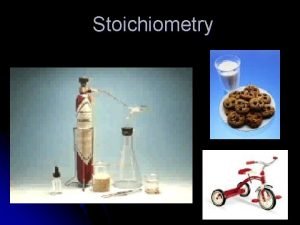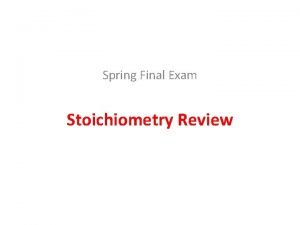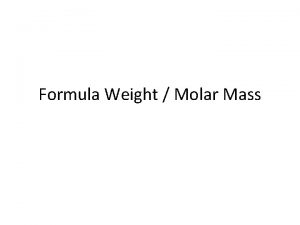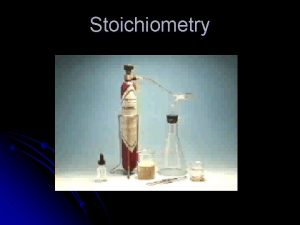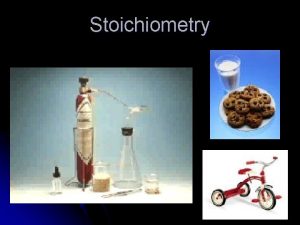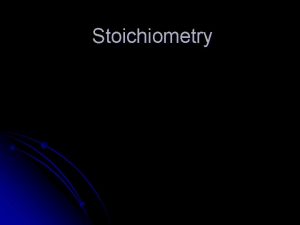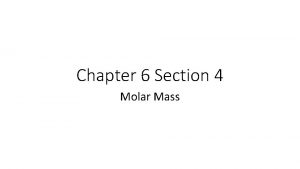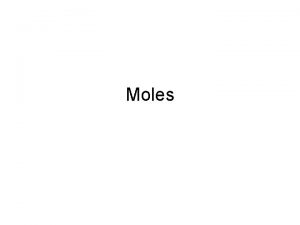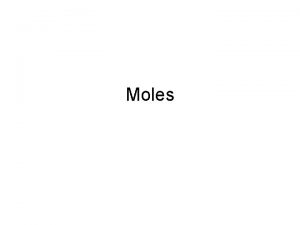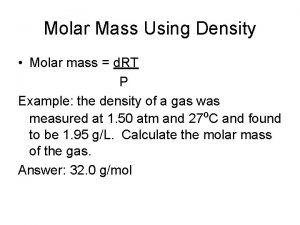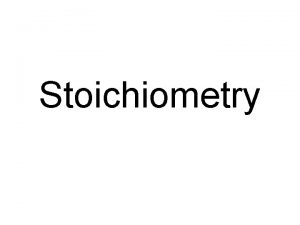Spring Final Exam Stoichiometry Review Molar Mass the
















- Slides: 16

Spring Final Exam Stoichiometry Review

Molar Mass the mass of one mole of a substance Pb. O 2 HNO 3 Pb: 1 (207. 2 g) = 207. 2 g O: 2 (16. 0 g) = 32. 0 g H: 1 (1. 0 g) = 1. 0 g N: 1 (14. 0 g) = 14. 0 g O: 3 (16. 0 g) = 48. 0 g 239. 3 g 63. 0 g

percentage composition: the mass % of each element in a compound g element x 100 % of element = molar mass of compound Find % composition. Pb. O 2 (NH 4)3 PO 4 (see calcs above) 207. 2 g Pb : 239. 2 g = 86. 6% Pb 32. 0 g O : 239. 2 g = 13. 4% O 42. 0 g N 12. 0 g H 31. 2 g P 64. 0 g O : 149. 0 g = = 28. 2% N 8. 1% H 20. 8% P 43. 0% O

Finding an Empirical Formula from Experimental Data 1. Find # of g of each element. 2. Convert each g to mol. 3. Divide each “# of mol” by the smallest “# of mol. ” 4. Use ratio to find formula. A compound is 45. 5% yttrium and 54. 5% chlorine. Find its empirical formula. YCl 3

To find molecular formula… A. Find empirical formula. B. Find molar mass of empirical formula. C. Find x = MM molecular MM empirical D. Multiply all parts of empirical formula by x. (How many empiricals “fit into” the molecular? )

A carbon/hydrogen compound is 7. 7% H and has a molar mass of 78 g. Find its molecular formula. emp. form. CH mmemp = 13 g 78 g =6 13 g C 6 H 6

A compound has 26. 33 g nitrogen, 60. 20 g oxygen, and molar mass 92 g. Find molecular formula. NO 2 mmemp = 46 g 92 g =2 46 g N 2 O 4

1 mol = molar mass (in g) Mass (g) Volume (L or dm 3) Island Diagram: 1 mol = 22. 4 L MOLE (mol) 1 mol = 22. 4 dm 3 Particle (at. or m’c) 1 mol = 6. 02 x 1023 particles a. Diagram has four islands. b. “Mass Island” for elements or compounds c. “Particle Island” for atoms or molecules d. “Volume Island”: for gases only 1 mol @ STP = 22. 4 L = 22. 4 dm 3

What mass is 1. 29 mol Iron (II) nitrate ? Fe 2+ NO 31– 1. 29 mol ( ) 179. 8 g 1 mol Fe(NO 3)2 = 232 g How many molecules is 415 L sulfur dioxide at STP? SO 2 415 L ( 1 mol 22. 4 L )( ) 6. 02 x 1023 m’c 1 mol = 1. 12 x 1025 m’c

What mass is 6. 29 x 1024 m’cules aluminum sulfate ? Al 3+ SO 42– Al 2(SO 4)3 342. 3 g 1 mol 6. 29 x 1024 m’c 6. 02 x 1023 m’c 1 mol ( )( ) = 3580 g At STP, how many g is 87. 3 L of nitrogen gas? N 2 87. 3 L ( 1 mol 22. 4 L )( 28. 0 g 1 mol )= 109 g

Chemical Reactions --Chemical Equations-- • During a chem. rxn. ; atoms are rearranged (NOT created or destroyed!) • Chemical equations must be balanced to show the relative amounts of all substances. • Balanced means: each side of the equations has the same # of atoms of each element. CH 4 + O 2 —> H 2 O + CO 2 Unbalanced CH 4 + 2 O 2 —> 2 H 2 O + CO 2 Balanced

Balanced? Cellulose reacts with oxygen gas to form carbon dioxide gas & liquid water. C 6 H 10 O 5 + 6 O 2 6 CO 2 + 5 H 2 O 6 10 17 C H O 6 10 17 Balanced!!!

Balanced? Nitroglycerin decomposes to form nitrogen gas, oxygen gas, carbon dioxide gas & water vapor 2 C 3 H 5(NO 3)3 3 N 2 + O 2 + 6 CO 2 + 5 H 2 O 6 10 6 18 C H N O 6 10 6 19 Not Balanced!

• When balancing equations, you may change coefficients as much as you need to, but you may never change subscripts because you can’t change what substances are involved.

Example: 2 H 2 (g) + O 2 (g) 2 H 2 O (l) 1. Atom Inventory: Reactants Products 4 2 H 2 4 2 O 1 2 2 Add coefficients to balance 3. Double check to make sure it is all BALANCED!

• Balancing Chemical Equations practice
 World history spring final exam review answers
World history spring final exam review answers Uncontrollable spending ap gov
Uncontrollable spending ap gov Stoichiometry molar mass
Stoichiometry molar mass Stoichiometry final exam
Stoichiometry final exam Stoichiometric calculations
Stoichiometric calculations Stoichiometry worksheet #2 (mole-mass mass-mole problems)
Stoichiometry worksheet #2 (mole-mass mass-mole problems) World history and geography final exam study guide
World history and geography final exam study guide Gram to mole
Gram to mole Molar mass unit
Molar mass unit Molar mass unit
Molar mass unit How to convert to molar mass
How to convert to molar mass Units of molar mass
Units of molar mass Formula mass vs molar mass
Formula mass vs molar mass Atomic mass vs molar mass
Atomic mass vs molar mass Spanish packet answers
Spanish packet answers Pltw human body systems final exam review
Pltw human body systems final exam review Poe final exam
Poe final exam


